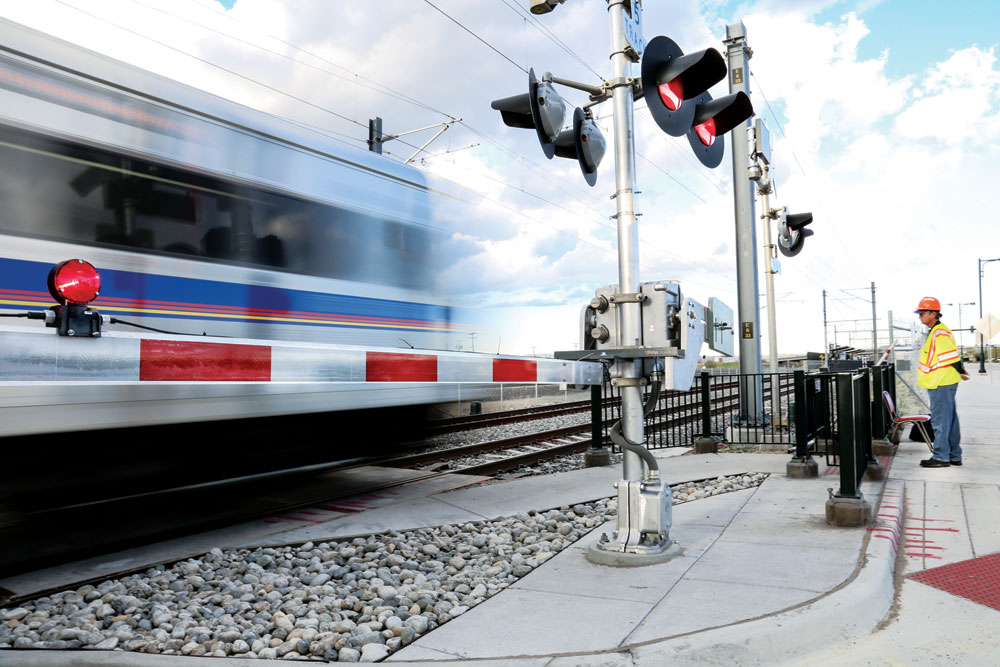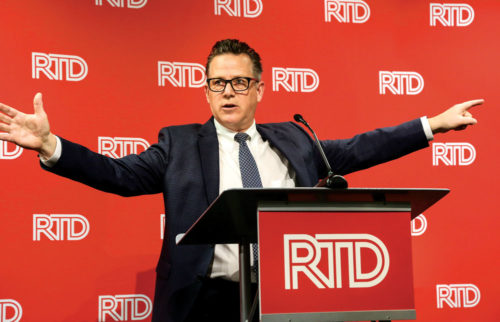
An A Line train leaves the Central Park Station.
For the foreseeable future, the A Line commuter rail cars will continue to blast their horns as they pass through street intersections on their trips between Union Station and the airport.
At an October press conference, RTD General Manager Dave Genova confirmed that until RTD receives full certification of its positive train control system (PTC), the process to convert the A Line corridor into a quiet zone cannot begin. He said the process for achieving quiet zone status takes 60 to 90 days. Once approved, freight trains, as well as the commuter rail vehicles, can run silently through the crossings.
A quiet zone is allowed by federal rule when certain safety standards are met at crossings. Those include gates, medians, signage, bells and lights, all of which have been installed on the A Line. However, the train continues to operate under a waiver from the Federal Railroad Administration (FRA) due to timing issues at those crossings (gates coming down too early and lifting too late). Gate timing is critical for the obvious safety reasons but also to minimize motorist frustration at lengthy delays that might lead some to slalom around the quad gate system. RTD attributes the problem to software issues in the system designed by its concessionaire, Denver Transit Partners.
The current FRA waiver was granted Oct. 16 and runs to Nov. 5, the latest in a series of waivers since the line began revenue service on April 22. In explaining the latest extension, an FRA spokesman said, “FRA has granted RTD a short-term, three-week extension to continue using flaggers with conditions. During this time, RTD must also develop a plan that demonstrates it has a path forward toward a solution to resolve the timing issues at the crossings.”

At an October press conference, RTD General Manager Dave Genova said they are testing a new software revision to resolve the timing issue at crossings. That issue is preventing the A Line from being certified for quiet crossings.
In response to a Front Porch inquiry, the FRA spokesperson said, “The PTC system has NOT been certified and is NOT fully implemented.” The shorter time extensions seem to indicate the FRA’s growing impatience at RTD’s ability to solve the gate timing problems. When asked whether the A Line might be shut down pending resolution of the PTC issues, the FRA spokesperson stated, only “If any railroad is found to not be following federal rail safety rules, FRA has various enforcement tools it can use.”
In a prepared statement read at the press conference, Genova said, “We are in the process of testing a new software revision to reduce the timing gaps … We are working diligently to resolve the grade crossing timing issue and gain final certification of the grade crossings with the FRA and the PUC (Colorado Public Utilities Commission). Once we complete this, we can also pursue the quiet zone process. Until then, we continue to operate with flaggers at the crossings as an additional safety measure and as required by the FRA and PUC.”
The FRA and PUC requirement for flaggers continues despite the fact that RTD’s extension waiver application included a request that “FRA’s requirement for flaggers be eliminated for all crossings. RTD believes that all crossings operate reliably with the exception of satisfying the required warning time performance.” The FRA rejected that portion of the waiver extension request.
PUC spokesman Terry Bote confirmed no field safety demonstration has been scheduled that would allow the PUC to eliminate the flagger requirement. The PUC has legal authority over all at-grade rail crossings in the state.
RTD spokesman Scott Reed said he did not know whether the FRA will continue to require flaggers if the waiver is extended again. An unanswered question at this point is the ability of flaggers to operate during adverse winter weather conditions.
At the press conference, Genova asserted, “We are operating a safe system and the grade crossings are activating the flashing lights, warning bells and gates well in advance of train arrival and in excess of the required minimum activation times. The flaggers at the crossings are an added safety measure in place until we complete the final certification of the crossings with the FRA and the PUC.” He emphasized that DTP is paying the cost of the flaggers.
In addition to that cost, DTP is incurring what RTD termed “severe penalties” intended to serve as an incentive for DTP to fully implement the PTC. Those penalties consist of payments withheld month by month for failing to meet performance requirements under its 34-year contract with RTD. Through September, those withheld payments, or deductions, amounted to $1.3 million or about 8.7 percent of what would have been full payments to DTP.
The A Line is part of RTD’s $2.2 billion EAGLE P3 project that also includes the B and G commuter rail lines and a centralized commuter rail maintenance facility. In addition to $450 million of financing contributed by Denver Transit Partners, the A Line is supported by a $1 billion grant from the Federal Transit Administration (FTA). A condition of the grant requires the train safety system to be fully functional by Dec. 31, 2016. An FTA spokesperson said, “Thus far, FTA has reimbursed RTD for most of the federal funding committed to the project, but not all, because the project is not yet complete. Like FRA, we are concerned about safety, and will defer to FRA’s jurisdictional authority over safety issues.”
On the upside, Genova touted the improving on-time performance of the A Line. It stands at 87.3 percent. He explained that on-time means arrival at a location no more than one minute early or no more than five minutes after the scheduled arrival time. Genova said the performance to date “is not good enough; we want to be at a minimum of 90 percent or better.”
He did express pleasure with ridership, saying the A Line is nearly at its one-year projected estimate of 18,600 weekday riders. Genova closed his prepared remarks by saying, “We are working with a sense of urgency and this is RTD’s No. 1 priority.”




As a resident along the A-Line Train corridor I am TIRED of hearing the horn at all hours. I had patience with RTD at first but after two extensions to get it together I’ve reached my limit! It’s been over a year and I’m furious at the noise pollution my community endures daily. While safety at crossing sections is a concern there is no regard for how this extremely loud and obnoxious horn impacts the those who live next door. How good would the RTD executives sleep if they had a blaring horn invading their slumber every 15-mintues? Those responsible for fixing this problem should be required to live in our neighborhood until we receive the quite zone approve. Maybe then they’ll feel the fire under their asses to get this fixed!